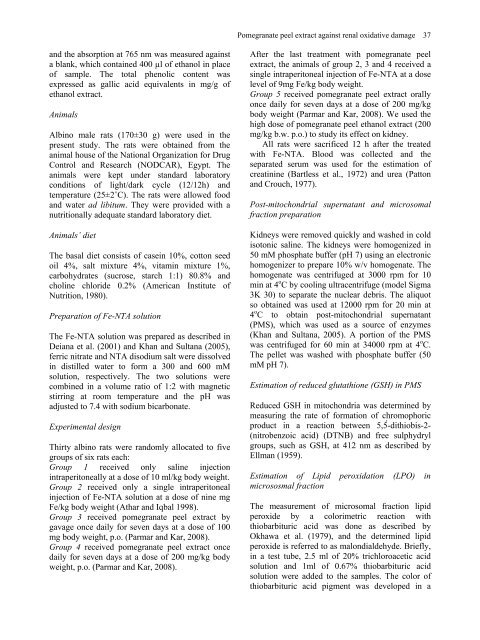Protective effect of pomegranate peel ethanol extract against ferric ...
Protective effect of pomegranate peel ethanol extract against ferric ...
Protective effect of pomegranate peel ethanol extract against ferric ...
Create successful ePaper yourself
Turn your PDF publications into a flip-book with our unique Google optimized e-Paper software.
and the absorption at 765 nm was measured <strong>against</strong><br />
a blank, which contained 400 µl <strong>of</strong> <strong>ethanol</strong> in place<br />
<strong>of</strong> sample. The total phenolic content was<br />
expressed as gallic acid equivalents in mg/g <strong>of</strong><br />
<strong>ethanol</strong> <strong>extract</strong>.<br />
Animals<br />
Albino male rats (170±30 g) were used in the<br />
present study. The rats were obtained from the<br />
animal house <strong>of</strong> the National Organization for Drug<br />
Control and Research (NODCAR), Egypt. The<br />
animals were kept under standard laboratory<br />
conditions <strong>of</strong> light/dark cycle (12/12h) and<br />
temperature (25±2˚C). The rats were allowed food<br />
and water ad libitum. They were provided with a<br />
nutritionally adequate standard laboratory diet.<br />
Animals’ diet<br />
The basal diet consists <strong>of</strong> casein 10%, cotton seed<br />
oil 4%, salt mixture 4%, vitamin mixture 1%,<br />
carbohydrates (sucrose, starch 1:1) 80.8% and<br />
choline chloride 0.2% (American Institute <strong>of</strong><br />
Nutrition, 1980).<br />
Preparation <strong>of</strong> Fe-NTA solution<br />
The Fe-NTA solution was prepared as described in<br />
Deiana et al. (2001) and Khan and Sultana (2005),<br />
<strong>ferric</strong> nitrate and NTA disodium salt were dissolved<br />
in distilled water to form a 300 and 600 mM<br />
solution, respectively. The two solutions were<br />
combined in a volume ratio <strong>of</strong> 1:2 with magnetic<br />
stirring at room temperature and the pH was<br />
adjusted to 7.4 with sodium bicarbonate.<br />
Experimental design<br />
Thirty albino rats were randomly allocated to five<br />
groups <strong>of</strong> six rats each:<br />
Group 1 received only saline injection<br />
intraperitoneally at a dose <strong>of</strong> 10 ml/kg body weight.<br />
Group 2 received only a single intraperitoneal<br />
injection <strong>of</strong> Fe-NTA solution at a dose <strong>of</strong> nine mg<br />
Fe/kg body weight (Athar and Iqbal 1998).<br />
Group 3 received <strong>pomegranate</strong> <strong>peel</strong> <strong>extract</strong> by<br />
gavage once daily for seven days at a dose <strong>of</strong> 100<br />
mg body weight, p.o. (Parmar and Kar, 2008).<br />
Group 4 received <strong>pomegranate</strong> <strong>peel</strong> <strong>extract</strong> once<br />
daily for seven days at a dose <strong>of</strong> 200 mg/kg body<br />
weight, p.o. (Parmar and Kar, 2008).<br />
Pomegranate <strong>peel</strong> <strong>extract</strong> <strong>against</strong> renal oxidative damage 37<br />
After the last treatment with <strong>pomegranate</strong> <strong>peel</strong><br />
<strong>extract</strong>, the animals <strong>of</strong> group 2, 3 and 4 received a<br />
single intraperitoneal injection <strong>of</strong> Fe-NTA at a dose<br />
level <strong>of</strong> 9mg Fe/kg body weight.<br />
Group 5 received <strong>pomegranate</strong> <strong>peel</strong> <strong>extract</strong> orally<br />
once daily for seven days at a dose <strong>of</strong> 200 mg/kg<br />
body weight (Parmar and Kar, 2008). We used the<br />
high dose <strong>of</strong> <strong>pomegranate</strong> <strong>peel</strong> <strong>ethanol</strong> <strong>extract</strong> (200<br />
mg/kg b.w. p.o.) to study its <strong>effect</strong> on kidney.<br />
All rats were sacrificed 12 h after the treated<br />
with Fe-NTA. Blood was collected and the<br />
separated serum was used for the estimation <strong>of</strong><br />
creatinine (Bartless et al., 1972) and urea (Patton<br />
and Crouch, 1977).<br />
Post-mitochondrial supernatant and microsomal<br />
fraction preparation<br />
Kidneys were removed quickly and washed in cold<br />
isotonic saline. The kidneys were homogenized in<br />
50 mM phosphate buffer (pH 7) using an electronic<br />
homogenizer to prepare 10% w/v homogenate. The<br />
homogenate was centrifuged at 3000 rpm for 10<br />
min at 4 o C by cooling ultracentrifuge (model Sigma<br />
3K 30) to separate the nuclear debris. The aliquot<br />
so obtained was used at 12000 rpm for 20 min at<br />
4 o C to obtain post-mitochondrial supernatant<br />
(PMS), which was used as a source <strong>of</strong> enzymes<br />
(Khan and Sultana, 2005). A portion <strong>of</strong> the PMS<br />
was centrifuged for 60 min at 34000 rpm at 4 o C.<br />
The pellet was washed with phosphate buffer (50<br />
mM pH 7).<br />
Estimation <strong>of</strong> reduced glutathione (GSH) in PMS<br />
Reduced GSH in mitochondria was determined by<br />
measuring the rate <strong>of</strong> formation <strong>of</strong> chromophoric<br />
product in a reaction between 5,5́-dithiobis-2-<br />
(nitrobenzoic acid) (DTNB) and free sulphydryl<br />
groups, such as GSH, at 412 nm as described by<br />
Ellman (1959).<br />
Estimation <strong>of</strong> Lipid peroxidation (LPO) in<br />
micrososmal fraction<br />
The measurement <strong>of</strong> microsomal fraction lipid<br />
peroxide by a colorimetric reaction with<br />
thiobarbituric acid was done as described by<br />
Okhawa et al. (1979), and the determined lipid<br />
peroxide is referred to as malondialdehyde. Briefly,<br />
in a test tube, 2.5 ml <strong>of</strong> 20% trichloroacetic acid<br />
solution and 1ml <strong>of</strong> 0.67% thiobarbituric acid<br />
solution were added to the samples. The color <strong>of</strong><br />
thiobarbituric acid pigment was developed in a
















